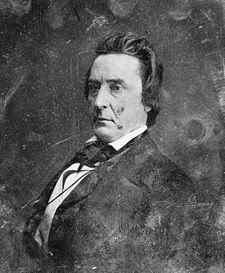David Rice Atchison{August 11, 1807}
David Rice Atchison was born on Tuesday, August 11, 1807 in Frogtown and he was a famous politician from United States. He is probably best known for the one day (March 4, 1849) that he was President of the United States.
Life in Brief:- Being born on Aug 11, David Rice was a Leo.
- his ethnicity: White.
- his mother's name: Catherine Allen.
- his father's name: William Atchison.
- Sister : Patsy Rollings Atchison.
He attended the Transylvania University, Lexington, KY (in 1825).
He died on Tuesday, January 26, 1886, in Gower; cause of death: unspecified.
Famous Why : US Senator from Missouri.
Know More Here...Early life
Atchison was born to William Atchison and his wife Catherine Allen in Frogtown (later Kirklevington), which is now part of Lexington, Fayette County, Kentucky. He was educated at Transylvania University in Lexington, where his classmates included five future Democratic Senators (Solomon Downs of Louisiana, Jesse Bright of Indiana, George W. Jones of Iowa, Edward Hannegan of Indiana, and Jefferson Davis of Mississippi). Atchison was admitted to the Kentucky bar in 1829.
Missouri lawyer and politician
In 1830 he moved to Liberty in Clay County in western Missouri, and set up practice there. He also farmed. Atchison's law practice flourished, and his best-known client was Mormon leader Joseph Smith, Jr.. Atchison represented Smith in land disputes with non-Mormon settlers in Caldwell County and Daviess County
Atchison was elected to the Missouri General Assembly in 1834. He worked hard for the Platte Purchase, which extended the northwestern boundary of Missouri to the Missouri River in 1837.
When the earlier disputes broke out into the so-called Mormon War of 1838, Atchison was appointed a general in the state militia and took part in suppression of the violence by both sides.
In 1838 he was re-elected to the Assembly. Three years later, he appointed a circuit court judge for the six-county area of the Platte Purchase. In 1843 he was named a county commissioner in Platte County, where he now lived.
Senate careerIn October 1843, Atchison was appointed to the U.S. Senate to fill the vacancy left by the death of Lewis F. Linn.He thus became the first senator from western Missouri. At age 36, he was the youngest senator from Missouri up to that time. Later in 1843, Atchison was elected to serve the remainder of Linn's term, and was re-elected in 1849.
Atchison was very popular with his fellow Senate Democrats. When the Democrats took control of the Senate in December 1845, they chose Atchison as President Pro Tempore, placing him second in succession for the Presidency, and also giving him the duty of presiding over the Senate when the Vice President was absent. He was then only 38 years old and had served in the Senate just two years. In 1849 Atchison stepped down as President Pro Tempore in favor of William R. King. King in turn yielded the office back to Atchison in December 1852, since King had been elected Vice President of the United States. Atchison continued as President Pro Tempore till December 1854.
As a Senator, Atchison was a fervent advocate of slavery and territorial expansion. He supported the annexation of Texas and the Mexican War. Atchison and Missouri's other Senator, the venerable Thomas Hart Benton became rivals and finally enemies, though both were Democrats. Benton declared himself to be against slavery in 1849, and in 1851 Atchison allied with the Whigs to defeat Benton for re-election.
Benton, intending to challenge Atchison in 1854, began to agitate for territorial organization of the area west of Missouri (now the states of Kansas and Nebraska) so it could be opened to settlement. To counter this, Atchison proposed that the area be organized and that the section of the Missouri Compromise banning slavery there be repealed in favor of popular sovereignty, under which the settlers in each territory would decide themselves whether slavery would be allowed.
At Atchison's request, Senator Stephen Douglas of Illinois introduced the Kansas-Nebraska Act, which embodied this idea, in November 1853. The Act became law on in May 1854, establishing the Territories of Kansas and Nebraska.
More Here...
















